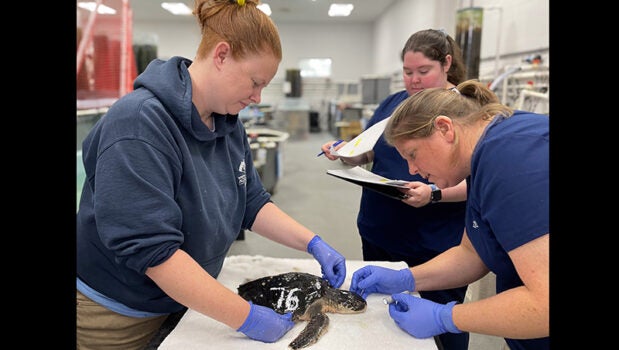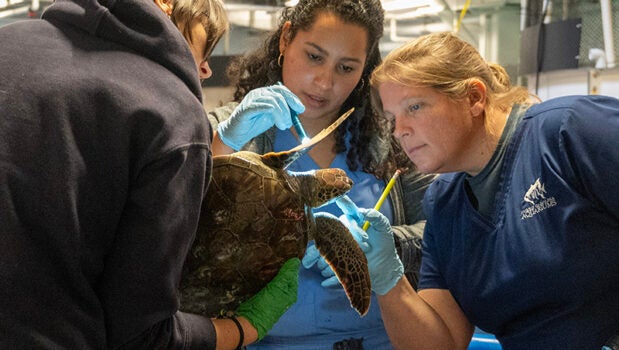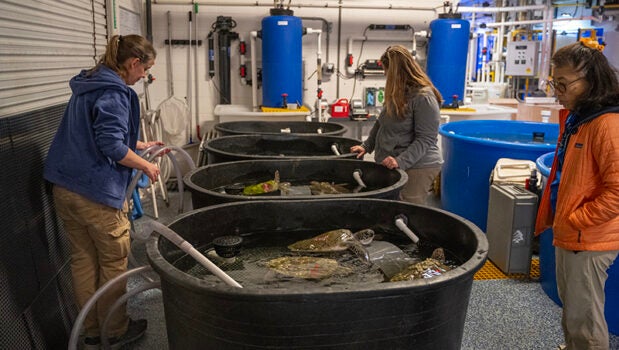Caught in the cold: Staff members at N.C. Aquariums care for cold-stunned sea turtles
Published 1:48 pm Saturday, January 27, 2024
|
Getting your Trinity Audio player ready...
|
The North Carolina Aquariums regularly care for sick or injured sea turtles throughout the year, but winter weather brings an influx of turtles due to cold-stunning events. So far this season, the aquariums have cared for more than 200 turtles caught in frigid water temperatures, unable to swim due to a hypothermia-like response.
Sea turtles are cold-blooded, which means their surroundings determine their body temperature. Juvenile green, loggerhead and Kemp’s ridley sea turtles use the area’s shallow sounds as rich feeding grounds in the summer and fall. When a turtle senses the cooling fall temperature, it usually heads for warmer waters. When temperatures drop too quickly, they miss their chance to leave and become cold-stunned.
“Their heart rate and other functions slow, leaving them lethargic and unable to swim,” said Michele Lamping, aquarist and sea turtle specialist for NCAPKS. “Prolonged exposure can result in paralysis, and the turtles float on the surface or wash up on beaches.”
Drastic changes in the weather along the coast in the last few weeks have led to many cold-stunned sea turtles needing rescue and rehabilitation. As of Tuesday, the North Carolina Aquarium at Roanoke Island (NCARI) is caring for 111 turtles, with more to arrive. The North Carolina Aquarium at Pine Knoll Shores (NCAPKS) is caring for 42 cold-stunned turtles. This year, the aquariums have already rehabilitated and released 63 cold-stunned sea turtles, including ones received from New England. These numbers fluctuate regularly as cold-stunned sea turtles continue to be found, rehabilitated and released.
The aquariums receive turtles from several coastal locations. Turtles found on the northern Outer Banks from Ocracoke to the Virginia state line are taken to the Sea Turtle Assistance and Rehabilitation (STAR) Center at NCARI. Turtles taken to NCAPKS were recovered from Cape Lookout National Seashore, Core Sound and oceanside areas.
The fieldwork to locate and transport the cold-stunned turtles to care facilities can be grueling work in frigid temperatures – biologists from Cape Hatteras National Seashore and Cape Lookout National Seashore, the N.C. Wildlife Resources Commission (NCWRC) and volunteers from sea turtle conservation groups like the Network for Endangered Sea Turtles (N.E.S.T.) locate, record and transport patients to regional facilities.
In the southern part of the state, the stranded turtles are taken to the Center for Marine Sciences and Technology (CMAST) in Morehead City for assessment and initial treatment. Once the turtles are triaged, the N.C. Aquarium veterinary team and the NCWRC work to divide the patients among rehabilitation centers along the coast, including the Karen Beasley Sea Turtle Rescue and Rehabilitation Center in Surf City and the N.C. Aquariums at Pine Knoll Shores and Fort Fisher.
From Ocracoke north, stranded turtles move through a staging site on Hatteras Island for documentation and then are transported directly to the STAR Center at the N.C. Aquarium on Roanoke Island. Initial assessment and treatments are completed there under the supervision of the veterinary team.
“Cold-stun rehabilitation can take anywhere from two weeks to multiple months, depending on the health status of the turtle when they arrive. We work closely with our veterinary team administer individual care to be sure that they are ready for release,” said Amber Hitt, STAR Center coordinator at NCARI.
During rehabilitation, the care team slowly warms up the turtles and ensures they can swim and lift their heads comfortably out of the water to breathe. A variety of foods are offered to tempt patients to eat. Along with nutritional care, technicians administer treatments prescribed by the vet team, including fluids, antibiotics, eye drops, and wound care. Once the turtles are healthy and have a final veterinary check, they are eligible for release. The last step is placing a small microchip in the front flipper of each turtle. If these turtles strand again, rehabbers and researchers can learn where they were seen last and how much they’ve grown.
It’s a group effort to care for and release the sea turtles. Winter releases require partnerships with boats that can release the turtles offshore. Typically, they are released in warm water near the Gulf Stream, 70 degrees F or above. Crews from Duke Marine Laboratory in Beaufort, the U.S. Coast Guard Stations at Cape Hatteras and Fort Macon, and private fishing vessels have helped release rehabilitated turtles.
The effort to rescue and rehabilitate sea turtles is led by the N.C. Wildlife Resources Commission, which collaborates with several federal, state and private organizations including North Carolina Aquarium on Roanoke Island, North Carolina Aquarium at Pine Knoll Shores, North Carolina Aquarium at Fort Fisher, Center for Marine Sciences and Technology, North Carolina State University College of Veterinary Medicine, Cape Lookout National Seashore, Karen Beasley Sea Turtle Rescue and Rehabilitation Center, Network for Endangered Sea Turtles (N.E.S.T.), Cape Hatteras National Seashore, U.S. Fish and Wildlife Service, National Marine Fisheries Service and National Oceanic and Atmospheric Administration (NOAA).
Those who see a turtle in the water or on the beach this time of year that is not moving or is sluggish are advised to not push the animal back into the water or attempt to transport it themselves. Call the Sea Turtle Stranding Hotline to report the turtle, and they will give instructions and send someone to retrieve and document the turtle.
On Ocracoke and Hatteras islands, call Cape Hatteras National Seashore at 252-216-6892. For Oregon Inlet and areas north, call N.E.S.T. at 252-441-8622. South of Ocracoke Island, call 252-241-7367.
SUBSCRIBE TO THE COASTLAND TIMES TODAY!









